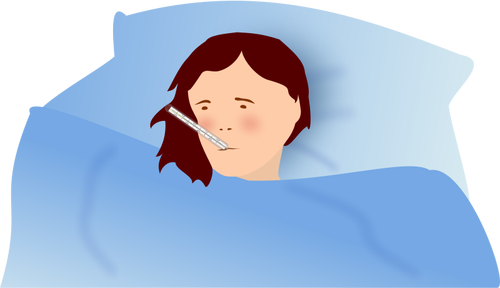Influenza, commonly referred to as the flu, is a contagious viral infection that primarily affects the respiratory system. Each year, millions of people worldwide suffer from the flu, experiencing symptoms that can range from mild to severe.
The duration of the flu varies from person to person, depending on various factors such as age, health status, and the specific strain of the virus. In this article, we will explore how long the flu typically lasts, modern treatment options, home remedies, and the latest advancements in flu management.
How Long Does the Flu Last?
The flu generally lasts between 5 to 7 days for most people, though the timeline can vary depending on individual health factors. Understanding the course of the flu can help patients manage expectations and aid in recovery.
Incubation Period:
The incubation period is the time between exposure to the flu virus and the onset of symptoms. This period typically lasts between 1 to 4 days, with symptoms appearing on average 2 days after exposure.
Symptoms Duration:
The primary flu symptoms—such as fever, body aches, chills, fatigue, cough, sore throat, and headache—usually peak within 2 to 3 days of onset. For most people, these symptoms subside gradually over the next few days, but they may persist for up to a week. In some cases, symptoms such as fatigue or a cough may linger for 2 weeks or more.
Post-Flu Fatigue:
Fatigue and weakness are common after the acute phase of the flu has passed. This post-viral fatigue can last for weeks, especially in individuals with weakened immune systems, the elderly, or those with chronic illnesses.
Severe Cases and Complications:
While most people recover from the flu within a week, certain groups of individuals are at higher risk for complications. For example, young children, the elderly, pregnant women, and individuals with compromised immune systems may experience more severe symptoms and prolonged illness.
In some cases, flu can lead to serious complications like pneumonia, bronchitis, and sinus or ear infections, which could extend the duration of illness.
Factors Influencing Flu Duration
Several factors influence how long the flu lasts and the severity of symptoms, including:
- Age: Older adults and young children may experience prolonged symptoms due to weaker or underdeveloped immune systems.
- Immune System Health: Individuals with a compromised immune system (due to conditions like HIV, cancer treatments, or autoimmune disorders) may take longer to recover.
- Flu Strain: Different strains of the flu virus can cause varying degrees of illness. For example, the H1N1 strain (swine flu) is often associated with more severe symptoms compared to other seasonal flu strains.
- Pre-existing Conditions: People with chronic conditions such as asthma, diabetes, or heart disease may experience prolonged flu symptoms or complications that delay recovery.
Home Remedies for Flu Relief
While there is no cure for the flu, several home remedies can help alleviate symptoms and promote a faster recovery. Below are some effective, natural ways to manage the flu:
Rest:
Rest is critical when recovering from the flu. It allows the body’s immune system to fight off the infection effectively. Adequate sleep helps strengthen the immune response and shortens the duration of the illness.
Hydration:
Flu symptoms such as fever and sweating can lead to dehydration, so it’s crucial to drink plenty of fluids. Water, herbal teas, broths, and electrolyte solutions (like oral rehydration salts) can help maintain hydration and support recovery.
Warm Saltwater Gargle:
Gargling with warm saltwater can help relieve a sore throat and reduce inflammation. The saltwater draws moisture out of swollen tissues and helps kill bacteria in the throat.
Steam Inhalation:
Inhaling steam from a bowl of hot water or using a humidifier can ease congestion and soothe irritated nasal passages. Adding essential oils like eucalyptus or peppermint may also help clear blocked sinuses.
Honey and Ginger:
Honey has natural antibacterial properties and can soothe a sore throat and cough. Ginger is an anti-inflammatory that can reduce pain and inflammation in the throat and chest. A warm tea made from ginger and honey can ease symptoms.
Vitamin C and Zinc:
Consuming foods rich in vitamin C (like oranges, strawberries, and bell peppers) and zinc (found in shellfish, legumes, and seeds) may help strengthen the immune system and speed up recovery.
Recent Technology-Based Treatments for the Flu
In addition to traditional home remedies, recent advances in medical technology have introduced new treatments that help manage flu symptoms and improve recovery times. Some of the most promising advancements include:
Antiviral Medications:
Prescription antiviral drugs like oseltamivir (Tamiflu), zanamivir (Relenza), and baloxavir (Xofluza) can reduce the duration and severity of flu symptoms if taken within the first 48 hours of symptom onset.
These medications work by inhibiting the flu virus’s ability to replicate, thereby shortening the duration of the illness by 1 to 2 days.
Point-of-Care Testing:
Advances in diagnostic technology have led to faster and more accurate flu tests. Rapid influenza diagnostic tests (RIDTs) can detect the flu virus in as little as 15 minutes, allowing for quicker diagnosis and treatment.
This technology also helps differentiate between the flu and other illnesses with similar symptoms, such as COVID-19.
Artificial Intelligence (AI) in Flu Monitoring:
AI is being increasingly used in the development of predictive models to track flu outbreaks in real time. Researchers are employing machine learning algorithms to analyze patterns in flu-related data, which helps predict the timing and severity of flu seasons.
This technology is also being applied to improve vaccine development and distribution.
Influenza Vaccines:
The development of a universal flu vaccine is a major ongoing research project. Recent studies are exploring vaccines that can target a broader range of flu strains, potentially eliminating the need for annual flu shots.
This would significantly reduce the global burden of seasonal flu.
Telemedicine:
Telemedicine has become a crucial tool during flu season, particularly in the wake of the COVID-19 pandemic.
Through virtual consultations, doctors can assess flu symptoms, recommend treatments, and monitor progress without the need for in-person visits, reducing the risk of spreading the virus.
Preventing the Flu
While managing flu symptoms is important, prevention is key to reducing the overall impact of the flu season. The most effective prevention strategy is vaccination.
Getting a yearly flu shot significantly reduces the risk of contracting the flu, as well as the severity of the illness if you do get sick.
Other preventive measures include:
- Washing hands frequently
- Avoiding close contact with infected individuals
- Staying home when sick
- Practicing good hygiene, like covering coughs and sneezes
Conclusion
The flu typically lasts 5 to 7 days, though recovery time can be affected by factors such as age, health conditions, and the strain of the virus.
While most people recover without significant complications, it’s essential to manage symptoms effectively through rest, hydration, and appropriate medical treatments.
Home remedies, such as honey, ginger, and warm saltwater gargles, can provide relief, while antiviral medications and advancements in technology, like rapid diagnostic tests and AI-based flu tracking, offer more targeted solutions.
By combining these modern treatments with preventive measures like vaccination, we can mitigate the impact of flu season and promote better public health.
Read More About : Silent Killer? The Shocking Truth About Uric Acid and Your Health!
Visit Us At : https://g.co/kgs/rTqAjgt





